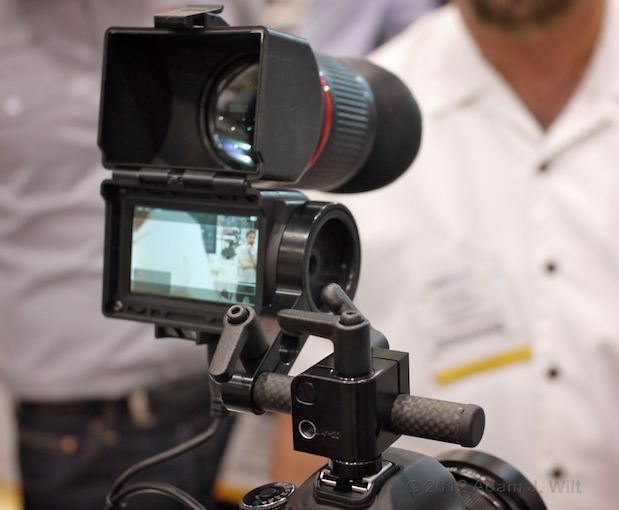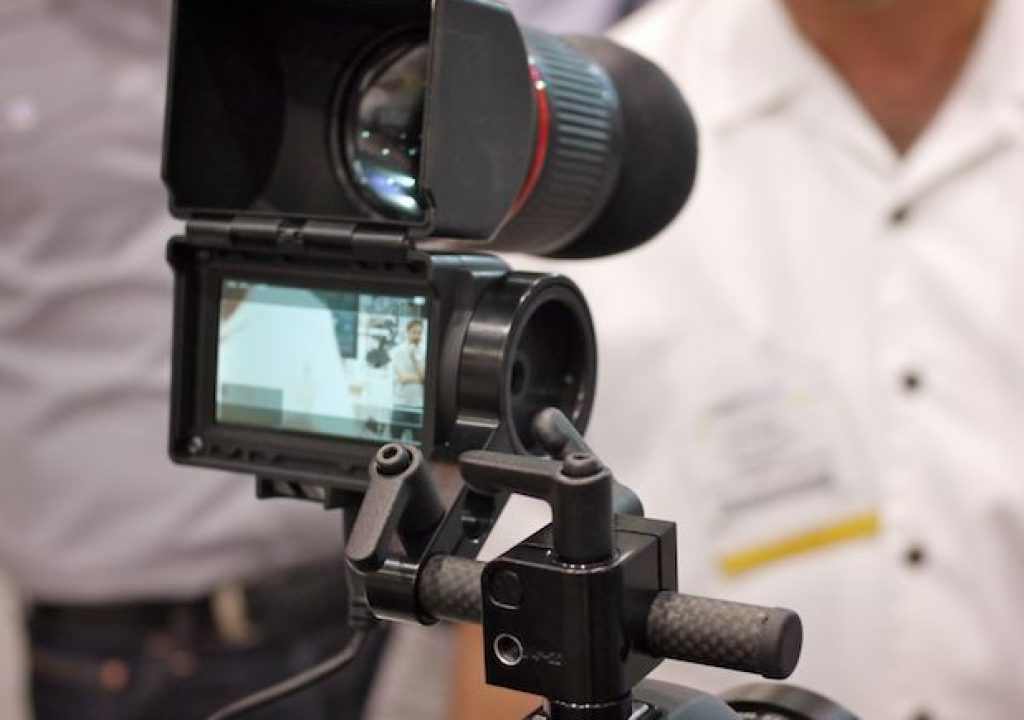
Kinotehnik’s LCDVFe showing a semitransparent mask.
Just when you thought you need only decide between Zacuto and Cineroid for add-on EVFs, NAB gave us two new choices. Also, Band Pro showed their own high-end EVF, and it’s a weird one.
Kinotehnik LCDVFe
Estonian company Kinotehnik previously gave us the LCDVF, a clip-on loupe turning a Canon DSLR’s LCD into a viewfinder. This year, they showed the LCDVFe, adding the LCD itself, substantial signal processing, and an elegant universal mount.
The LCDVFe comes with a carbon-fibre universal mounting system.
The LCDVFe has an elegant and functionally rich menu system.
The LCDVFe uses a four-way button array, plus menu and power buttons.
The LCDVFe has a 3″ 800×480 screen and runs off of four internal AA batteries or 4-17 volts of external DC power. It has HDMI in and out.
Manios Digital is the US distributor, and the US price will be around $980. Shipping Real Soon Now.
Alphatron EVF
Dutch company Alphatron contracted with TV Logic to produce the EVF-035W-3G, a 3.5″, 960×540 (active area) EVF.
Alphatron’s EVF is controlled by buttons and a scroll wheel.
Alphatron’s 3.5″ display next to that of the NEX-FS100.
HD-SDI in and out, HDMI in and out, and room for an NP-F battery.
The Alphatron accepts either HDMI or HD-SDI and output the same; it also converts HDMI to HD-SDI if needed. It runs from an NP-F (Sony camcorder) internal battery or from a 6-15 volt external DC feed. In the US, Abel Cine will carry it, probably starting in June, for $1395.
Both of these EVFs use decently-sized LCDs combined with big, bright magnifier eyepieces, so you’ll see a large, detailed image. The Alphatron, with its half-HD-res screen (actually 960×640, the same as a Retina-display iPhone, though only 960×540 is used for a 16×9 image) has a slight resolution advantage, and it’ll accept both SDI and HDMI, but it does cost a bit more.
(Both the Zacuto and Cineroid offerings use 3.2″ screens with 800×480 resolution, in case you’re wondering.)
Band Pro NewFinder EVF
Band Pro’s EVF is built like a tank.
Band Pro is partnering with Astrodesign to build the NewFinder EVF, which uses a true 1920×1080 LCOS panel to show a full-res image.
It’s built like a brick shi—erm, like a tank: a solid metal housing, serious metal knobs (yes, knobs, letting you tweak the picture without menu-diving… just like a real viewfinder!), and the like. A product of the digital era, it connects via analog… to the YPrPb viewfinder connectors of high end cameras like the F65 (a later version will have an HD-SDI option, but analog has the advantage of needing less processing; the NewFinder’s analog feed results in under one frame of delay).
Price will be something like $11,000—steep for us little guys, but competitive with the HDVF-C30W color EVF, Sony’s standard 2.7″, 960×540 LCD EVF for its high-end cine cameras. The NewFinder’s full HD resolution should make focus-finding a lot easier for those complaining that the HDVF-C30W doesn’t resolve enough fine detail…
…except that, at least on the prototype finder at Band Pro’s booth, the eyepiece lens displayed a very small, distant picture, not unlike using the EVFs on the recent Panasonic handhelds. Instead of seeing a big, detailed movie-screen of an image, I found myself peering down a long, dark tunnel at a tiny little picture, a picture so small it could just as easily have been 800×480, 640×360, or less, and there’d be no way of telling the difference.
What’s the point of a 1920×1080 display when it subtends such a small visual angle that you can’t distinguish it from a standard-def picture? I certainly applaud the goal of creating a full-res, truly focusing-capable EVF, but this prototype NewFinder misses the point of the exercise. I can only hope that the eyepiece magnifier on this prototype is not representative of the final product; the displayed image needs to appear about twice as large as it did at NAB if the NewFinder is to fulfill its stated goal.
Like I said, weird. Or am I missing something?
Disclosures: I attended NAB on my own dime, with a press pass to save the cost of admission. The NAB did not provide the pass in exchange for any promise of positive coverage, nor did they influence me in any way before or afterwards.
There is no material connection between me and any of the manufacturers covered in the article, and nobody offered any inducements for favorable coverage (other than appearing at the show and having interesting things to look at).

